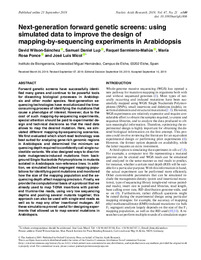Por favor, use este identificador para citar o enlazar este ítem:
https://hdl.handle.net/11000/30807Registro completo de metadatos
| Campo DC | Valor | Lengua/Idioma |
|---|---|---|
| dc.contributor.author | Wilson-Sánchez, David | - |
| dc.contributor.author | Lup, Samuel Daniel | - |
| dc.contributor.author | Sarmiento, Raquel | - |
| dc.contributor.author | Ponce, María Rosa | - |
| dc.contributor.author | Micol, José Luis | - |
| dc.contributor.other | Departamentos de la UMH::Biología Aplicada | es_ES |
| dc.date.accessioned | 2024-01-26T22:54:13Z | - |
| dc.date.available | 2024-01-26T22:54:13Z | - |
| dc.date.created | 2019-09-23 | - |
| dc.identifier.citation | Nucleic Acids Research, 2019, Vol. 47, No. 21 | es_ES |
| dc.identifier.issn | 1362-4962 | - |
| dc.identifier.issn | 0305-1048 | - |
| dc.identifier.uri | https://hdl.handle.net/11000/30807 | - |
| dc.description.abstract | Forward genetic screens have successfully identified many genes and continue to be powerful tools for dissecting biological processes in Arabidopsis and other model species. Next-generation sequencing technologies have revolutionized the time-consuming process of identifying the mutations that cause a phenotype of interest. However, due to the cost of such mapping-by-sequencing experiments, special attention should be paid to experimental design and technical decisions so that the read data allows to map the desired mutation. Here, we simulated different mapping-by-sequencing scenarios. We first evaluated which short-read technology was best suited for analyzing gene-rich genomic regions in Arabidopsis and determined the minimum sequencing depth required to confidently call single nucleotide variants. We also designed ways to discriminate mutagenesis-induced mutations from background Single Nucleotide Polymorphisms in mutants isolated in Arabidopsis non-reference lines. In addition, we simulated bulked segregant mapping populations for identifying point mutations and monitored how the size of the mapping population and the sequencing depth affect mapping precision. Finally, we provide the computational basis of a protocol that we already used to map T-DNA insertions with paired-end Illumina-like reads, using very low sequencing depths and pooling several mutants together; this approach can also be used with single-end reads as well as to map any other insertional mutagen. All these simulations proved useful for designing experiments that allowed us to map several mutations in Arabidopsis. | es_ES |
| dc.format | application/pdf | es_ES |
| dc.format.extent | 14 | es_ES |
| dc.language.iso | eng | es_ES |
| dc.publisher | Oxford University Press | es_ES |
| dc.rights | info:eu-repo/semantics/openAccess | es_ES |
| dc.rights | Attribution-NonCommercial-NoDerivatives 4.0 Internacional | * |
| dc.rights.uri | http://creativecommons.org/licenses/by-nc-nd/4.0/ | * |
| dc.subject.classification | Genética | es_ES |
| dc.subject.other | CDU::5 - Ciencias puras y naturales::57 - Biología | es_ES |
| dc.title | Next-generation forward genetic screens: using simulated data to improve the design of mapping-by-sequencing experiments in Arabidopsis | es_ES |
| dc.type | info:eu-repo/semantics/article | es_ES |
| dc.relation.publisherversion | https://doi.org/10.1093/nar/gkz806 | es_ES |

Ver/Abrir:
Wilson-Sánchez et al 2019.pdf
737,43 kB
Adobe PDF
Compartir:
 La licencia se describe como: Atribución-NonComercial-NoDerivada 4.0 Internacional.
La licencia se describe como: Atribución-NonComercial-NoDerivada 4.0 Internacional.
.png)